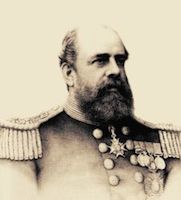Vice Admiral Sir George Tryon

George Tryon was born on 4 January 1832 at Bulwick Park, Northamptonshire, England, son of Thomas Tryon and his wife Anne, daughter of Sir John Trollope, Bart. Educated at Eton, he entered the Navy as a Cadet in HMS Wellesley in 1848 and passed his Midshipman's examination at 18, gaining the high regard of his superiors for his intellect and disposition.
Tryon served with distinction in the Crimean War, promoted Acting Lieutenant he was confirmed in that rank in 1855. He served in the Black Sea before being posted in 1858 to the Queen's escort to Cherbourg, which resulted in an appointment to the Royal Yacht. Thereafter, his career was closely associated with innovation and improvement of several aspects of the service. Promoted Commander in 1860, next year he was appointed to HMS Warrior, the first British sea-going ironclad. He received his own command in 1864, became a Captain in 1866 and attended the Royal Naval College, Portsmouth. Next year he was appointed Director of Transports at Annesley Bay in the Red Sea, landing troops and supplies for the Abyssinian expedition, work that gained him the CB in 1868. On 5 April 1869 in London he married the Honourable Clementina Charlotte, daughter of Gilbert John Heathcote, first Lord Aveland.
In 1871 Tryon was made Private Secretary to GJ Goschen, First Lord of the Admiralty. In 1874 he was given command of HMS Raleigh, another experimental warship, and in 1877, by reason of his reputation as a tactician, was appointed to committees for revision of the signal book and manual of fleet evolutions. Following command of the prestigious HMS Monarch, in 1882 he became Secretary to the Admiralty, the last naval officer to hold that post; he established a Department of Naval Intelligence and contributed to the blue-water versus bricks and mortar debate which resulted in the Navy regaining ascendancy over the Army.
A Rear Admiral in April 1884, Tryon was influential in the establishment of the Australia Station and in December was appointed its first Commander-in-Chief; he arrived in Sydney on 22 January 1885 in the Indus. His wife did not accompany him but he entertained Sydney society at Admiralty House with long-remembered hospitality. His handsome presence and robust, cheery personality combined with high professional ability made him the confidant of many important people in Australia. Among his first duties was an inquiry into the native labour trade between Queensland and the Pacific islands; it led to his inclusion in discussions regarding the annexation of New Guinea. The heightened colonial consciousness of defence following the Russian scare of early 1885 gained Tryon much publicity, which he used to urge increased naval effort. He proposed greater colonial participation in defence of the general Australian area by an auxiliary squadron not limited to the Australian coast, an integral part of his concept was his opposition to payment to Britain in return for protection. But Admiralty policy was opposed to a colonial blue-water capability and a policy of monetary contribution was accepted by colonial leaders at the 1887 Imperial Conference in London, to which Tryon had not been invited. As a result, Tryon asked to be relieved of his command and left Australia in the HMS Ballarat on 19 April 1887. He had filled the Victorian naval forces with his nominees, but failed to forge a coherent Australian unit or effect involvement in defence beyond coastal waters. Nevertheless, he stimulated a school of thought which eventually produced the RAN.
On his return to Britain Tryon was created Knight Commander of the Order of the Bath (KCB) and appointed Superintendent of Reserves, which allowed him to pursue his interests in tactics and other matters. In 1889 he was promoted Vice Admiral, and in 1891 became Commander-in-Chief, Mediterranean Station, where he implemented many of his ideas on training, including the introduction of a greater sense of realism into fleet manoeuvres. He was drowned following a collision on 22 June 1893 between his flagship, HMS Victoria, and a consort, HMS Camperdown, in a manoeuvre ordered by him and generally regarded as a lapse of judgment. His body was not recovered. Subsequent controversy concentrated on the risk inherent in his methods and tended to obscure his great contribution to naval development. He was survived by his wife (d.1922) and son George Clement, later a major in the 3rd Grenadier Guards and Conservative MP for Brighton in the House of Commons.


